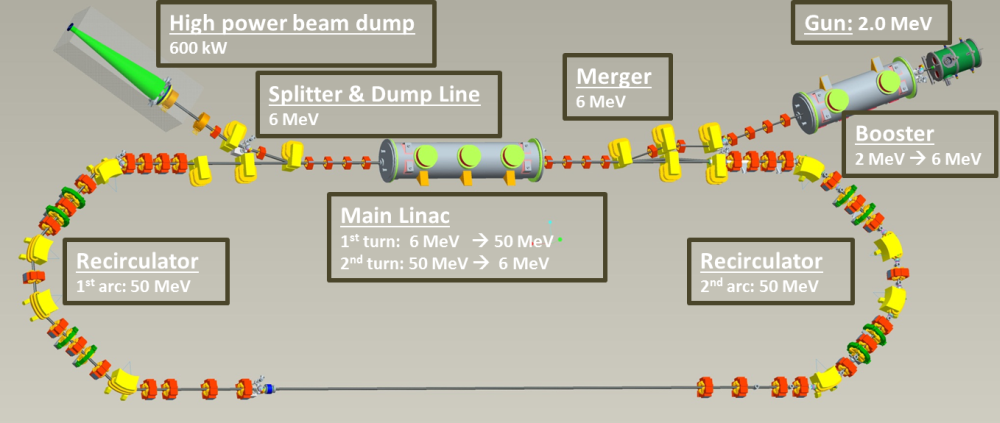bERLinPro
bERLinPro - An Overview
To demonstrate the ERL principle at ultimate beam properties – highest average current and most dense electron bunches - HZB proposed to build a 100-MeV high-current ERL test facility (BERLinPro) that can put all subsystems relevant to large-scale ERLs to the test and enable the rigorous comparison of theory with the real world. Submitted to the Helmholtz Association in 2008, the project proposal received final approval in October 2010.
Following approval and formation of the project team a more detailed layout was then developed, which enabled detailed costing and scheduling of the facility construction. At that point it became apparent that a 100-MeV ERL could not be realized within the fiscal constraints so that a descope to 50 MeV was presented to the newly installed international Machine Advisory Committee (MAC). While this change reduces the number of SRF systems and the required costly radiation shielding, the beam parameters (current, emittance, bunch length) were left unaltered. Hence the scope and relevance of the physics and technology development remains fully intact. The MAC endorsed this approach, which then was used as the baseline for the subsequent development of the conceptual design report (CDR-link).
BERLinPro’s layout as a single-pass ERL is shown in Figure 1. Its 6-MeV injection line consists of a 1.3 GHz SRF photo injector and a three cavity booster section. The beam is merged into the main linac via a dog-leg merger where it is accelerated by three 7-cell SRF cavities to 50 MeV. Following recirculation via the straight section reserved for future experiments, the decelerated beam is dumped in a 600-kW beam dump at 6-MeV.
Since bERLinPro is a “generic” demonstration facility for accelerator R&D rather than being designed as a specific user facility, its parameter set should be considered flexible. Given HZB’s background in the operation of synchrotron light sources, a set suitable for future X-ray light-source applications, as listed in Table 1, has been adopted as the “standard mode.” However, the optics design is intentionally flexible to allow future exploration of a wide range of other parameters, including short and low energy spread bunches. Room is also provided in the return arc to install future experiments or insertion devices that can demonstrate the potential of ERLs for various user applications.
The study and minimization of beam loss will be one of the key aspects of the bERLinPro measurement program. Radiation protection must be designed to accommodate a worst-case continuous beam loss scenario. For a cost-effective solution, the accelerator will be housed in a subterranean building with all auxiliary systems placed in a separate, above ground, building. Importantly, the layout of the accelerator hall provides sufficient room for a future upgrade to two-turn recirculation, provided additional funding is secured. Its study can provide valuable results for future large-scale facilities.
Given the long lead time in developing a high-current photo injector, first experiments with an all-superconducting system (SRF cavity, superconducting cathode, superconducting solenoid) commenced in 2010. The focus continuous to be on the injector and a new version that includes a normal conducting cathode capable of generating high currents will be constructed in 2013. In the meantime the ERL optics layout, as presented in this CDR, has been developed so that an application for a building permit (“Errichtungsgenehmigung”) will be submitted shortly to German authorities. The goal is to have the bERLinPro building ready for occupancy in 2014. A staged installation of bERLinPro will follow, the primary focus being on accelerating a high (100 mA) current beam by 2016, albeit only up to 6 MeV. Following this, the main linac and recirculation will be installed so that full energy recovery is expected by 2018.


